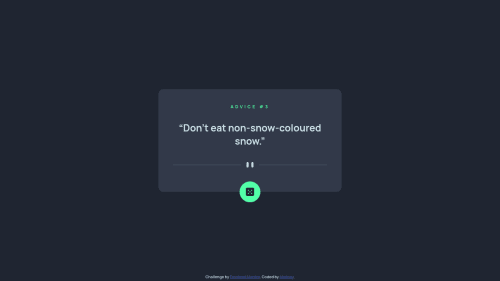Advice slip using fetch API

Solution retrospective
I found it difficult to make it look right for Galaxy Fold. It would mess with my grid/flexbox.
I had to use query selector inside my .then statements. It did not work right outside of it. I do not think this is best practice as examples I saw did not do this and declared outside of it first.
Please log in to post a comment
Log in with GitHubCommunity feedback
- @Itskrish01
Hey, I just checked and discovered that every time I click the button it does not show me new advice. To fix this you can use the boolean isLoading state to check if the advice is isLoading and add a loading animation and disabled the button while the isLoading is true, add debounce so you can show the data every time you click the button. because right now when I click the button I make another request when the previous one is not even completed you can fix it by using this method.
Marked as helpful - @0xabdulkhaliq
Hello there 👋. Congratulations on successfully completing the challenge! 🎉
- I have other recommendations regarding your code that I believe will be of great interest to you.
HTML 🏷️:
- This solution generates accessibility error reports, "All page content should be contained by landmarks" is due to
non-semanticmarkup, which lack landmark for a webpage
- So fix it by replacing the
<div class="advice-container">element with the semantic element<main>along with<div class="attribution">into a<footer>element in yourindex.htmlfile to improve accessibility and organization of your page.
- What is meant by landmark ?, They used to define major sections of your page instead of relying on generic elements like
<div>or<span>
- They convey the structure of your page. For example, the
<main>element should include all content directly related to the page's main idea, so there should only be one per page
HEADINGS ⚠️:
- And, this solution has also generated accessibility error report due to lack of level-one heading
<h1>
- Every site must want at least one
h1element identifying and describing the main content of the page.
- An
h1heading provides an important navigation point for users of assistive technologies, allowing them to easily find the main content of the page.
- So we want to add a level-one heading to improve accessibility by reading aloud the heading by screen readers, you can achieve this by adding a
sr-onlyclass to hide it from visual users (it will be useful for visually impaired users)
BUTTONS 🖲️:
- This solution had generated accessibility error reports due to lack discernible text for
<button>element
- The
<button>must have discernible text that clearly describes the destination, purpose, function, or action for screen reader users.
- Screen reader users are not able to discern the purpose of elements with role="link", role="button", or role="menuitem" that do not have an accessible name.
- The
<button>name rule has five markup patterns that pass test criteria:
<button id="al" aria-label="Name"></button> <button id="alb" aria-labelledby="labeldiv"></button> <div id="labeldiv">Button label</div> <button id="combo" aria-label="Aria Name">Name</button> <button id="buttonTitle" title="Title"></button>-
Ensure that each
<button>element and elements withrole="button"have one of the following characteristics:- Inner text that is discernible to screen reader users.
- Non-empty
aria-labelattribute. aria-labelledbypointing to element with text which is discernible to screen reader users.role="presentation"orrole="none"(ARIA 1.1) and is not in tab order (tabindex="-1")
. .
I hope you find this helpful 😄 Above all, the solution you submitted is great !
Happy coding!
Marked as helpful
Join our Discord community
Join thousands of Frontend Mentor community members taking the challenges, sharing resources, helping each other, and chatting about all things front-end!
Join our Discord